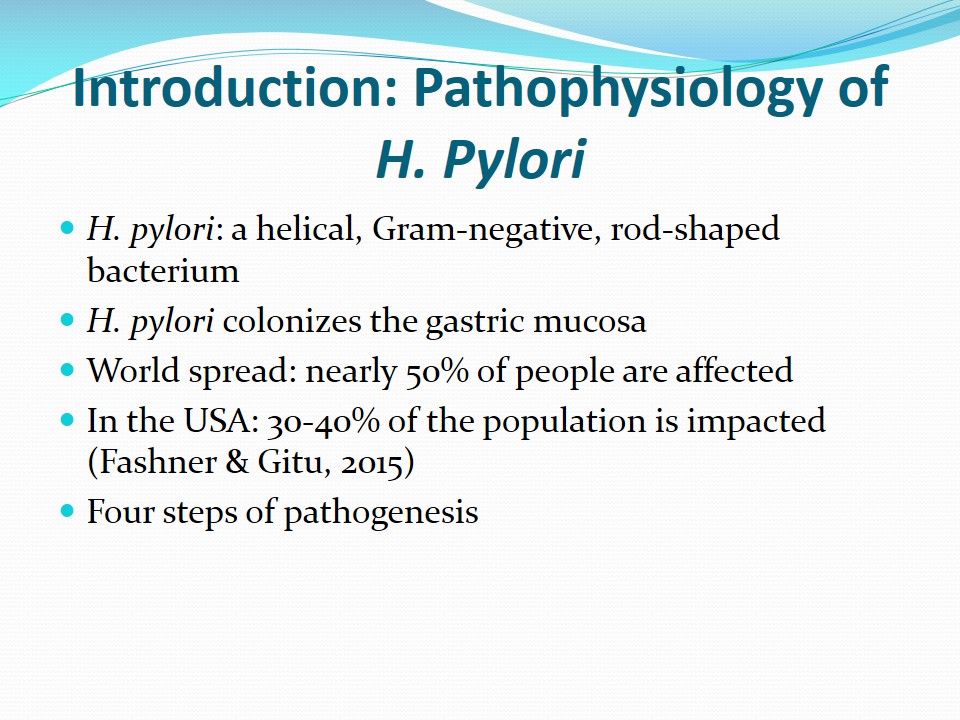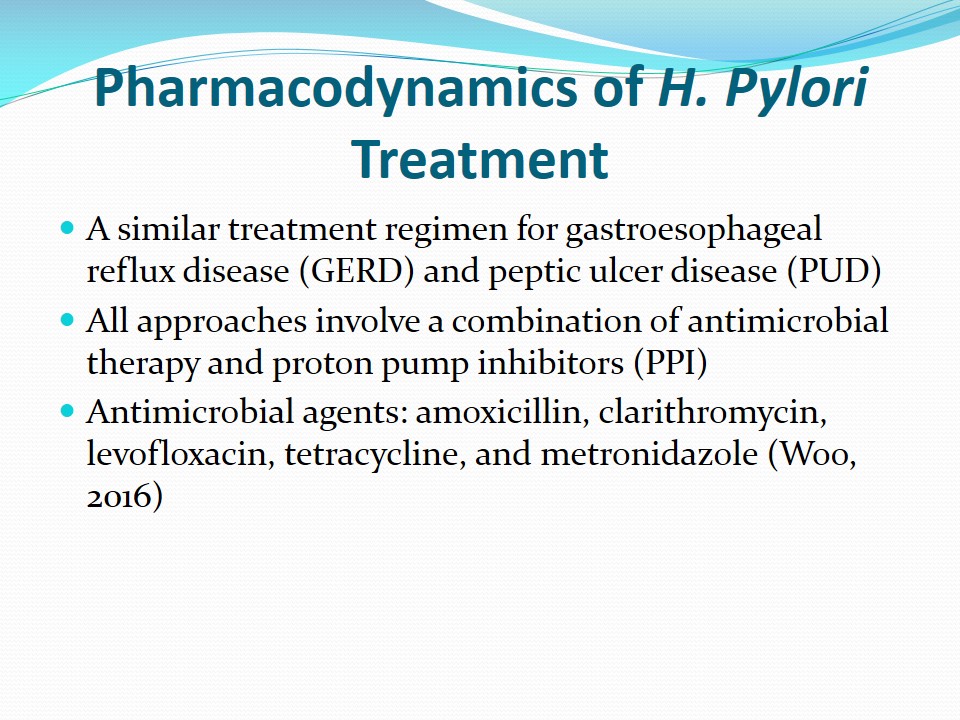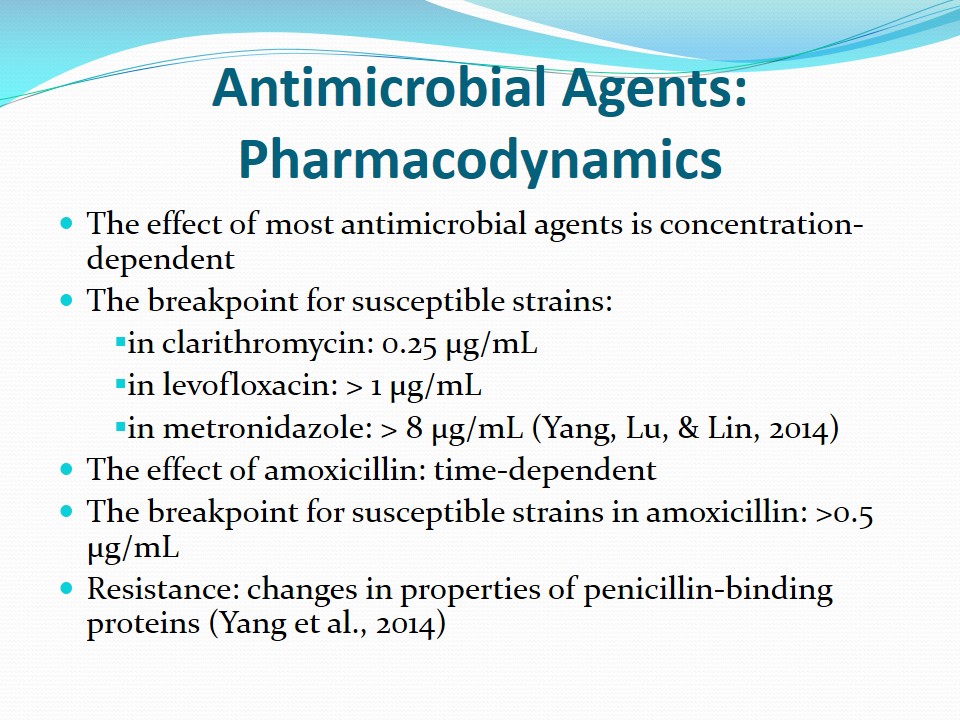Introduction: Pathophysiology of H. Pylori
- H. pylori: a helical, Gram-negative, rod-shaped bacterium.
- H. pylori colonizes the gastric mucosa.
- World spread: nearly 50% of people are affected.
- In the USA: 30-40% of the population is impacted (Fashner & Gitu, 2015).
- Four steps of pathogenesis.
H. pylori is reported to be present in 70% of patients suffering from gastric ulcers and in 95% of individuals having duodenal ulcers (Fashner & Gitu, 2015). The common way of transmission of this bacterium is through the fecal-oral route. The transmission starts in early childhood and then persists for decades. H. pylori is a widely known agent of duodenal and gastric ulcers. Also, the bacterium is a common risk factor for gastric adenocarcinoma and mucosa-associated lymphoid tissue (MALT) lymphoma (Fashner & Gitu, 2015). Upon the bacterium’s entering the stomach, four steps of pathogenesis are identified: surviving in the acidic stomach, moving toward epithelium cells, attaching to host cells through the receptor or adhesin interaction, and damaging tissue by the release of toxins (Kao, Sheu, & Wu, 2016).

Pharmacodynamics of H. Pylori Treatment
- A similar treatment regimen for gastroesophageal reflux disease (GERD) and peptic ulcer disease (PUD).
- All approaches involve a combination of antimicrobial therapy and proton pump inhibitors (PPI).
- Antimicrobial agents: amoxicillin, clarithromycin, levofloxacin, tetracycline, and metronidazole (Woo, 2016).
Pharmacodynamics of H. pylori treatment is almost the same both for PUD and GERD. Antimicrobial agents are prescribed in a triple or quadruple drug regimen that involves bismuth subsalicylate (Woo, 2016). A combination of the antimicrobial and the PPI leads to acid suppression that promotes the alleviation of ulcer-related symptoms. Additionally, such treatment helps to heal gastric mucosal inflammation and may sometimes improve the efficacy of antimicrobial agents against H. pylori at the mucosal surface (Woo, 2016).

Treatment Regimen: First-Line
- First-line regimen:
- Standard triple therapy;
- Sequential therapy.
Standard triple therapy includes PPI, amoxicillin 1 g, and clarithromycin 500 mg two times daily. The duration of this treatment is 7-10 days, but it may be prolonged up to 14 days. This is a preferred therapy, and the eradication rate of H. pylori constitutes 70-85% (Fashner & Gitu, 2015). Another variation of standard triple therapy is PPI, clarithromycin 500 mg, and metronidazole 500 mg two times daily from 10 to 14 days.
Sequential therapy, which requires validation in the USA, is divided into two regimens. The first one involves PPI and amoxicillin 1 g two times a day. The second regimen includes PPI, clarithromycin 500 mg, and metronidazole or tinidazole 500 mg twice daily (Fashner & Gitu, 2015). This treatment guarantees up to 84% eradication rate of H. pylori.

Treatment Regimen: Second-Line
- Second-line regimen:
- Non-bismuth based quadruple therapy (concomitant treatment);
- Bismuth-based quadruple therapy;
- Levofloxacin-based triple therapy (Fashner & Gitu, 2015).
Non-bismuth based quadruple therapy includes PPI, clarithromycin 500 mg, amoxicillin 1 g, and metronidazole or tinidazole 500 mg two times daily (Fashner & Gitu, 2015). The duration of treatment is 10 days, and the eradication rate is 90%. This approach is simpler than sequential therapy while presenting a similar eradication level.
Bismuth-based quadruple therapy includes (1) PPI two times daily and (2) bismuth subsalicylate 525 mg or subcitrate 300 mg, tetracycline 500 mg, and metronidazole 250 mg four times a day (Fashner & Gitu, 2015). The treatment period is 10-14 days, and it can be used in case first-line therapy fails.
Levofloxacin-based triple therapy is used as a salvage approach only and requires validation in the USA.

Antimicrobial Agents: Pharmacodynamics
- The effect of most antimicrobial agents is concentration-dependent.
- The breakpoint for susceptible strains:
- In clarithromycin: 0.25 μg/mL;
- In levofloxacin: > 1 μg/mL;
- In metronidazole: > 8 μg/mL (Yang, Lu, & Lin, 2014).
- The effect of amoxicillin: time-dependent.
- The breakpoint for susceptible strains in amoxicillin: >0.5 μg/mL.
- Resistance: changes in properties of penicillin-binding proteins (Yang et al., 2014).
The efficacy of most antimicrobial agents is related to their plasma concentration. In some agents, such as amoxicillin, the effect is time-dependent (Yang et al., 2014). What concerns resistance, the most common mechanism is the alteration in the penicillin-binding protein’ properties. Another amoxicillin-resistance process is the reduced membrane permeability that may cause the low accumulation of amoxicillin (Yang et al., 2014). For clarithromycin, the point mutation in the 23S rRNA gene is the major resistance mechanism. The most frequent mutation occurs at A2143G (69.8%) (Yang et al., 2014).

Nursing Implications
- The major goal: the eradication of H. pylori.
- Other implications:
- Oincreasing the intragastric pH;
- Opreventing the development of other related diseases;
- Oassuring the best treatment outcome.
It is highly crucial to eradicate H. pylori since it can lead to serious complications. To reach this aim, combinations of antimicrobial and antisecretory agents have been offered as first-line or second-line approaches (Yang et al., 2014). The increase in the intragastric pH is necessary for the beneficial effect of antibiotics. Additionally, healthcare professionals are concerned with the effective pharmacological management of H. pylori because this bacterium can cause the initiation of other serious conditions. It is vital to select the most suitable treatment regimen since many patients are resistant to some agents (Yang et al., 2014). The successful treatment of H. pylori enables patients to avoid adverse events.

References
Fashner, J., & Gitu, A. C. (2015). Diagnosis and treatment of peptic ulcer disease and H. pylori infection. American Family Physician, 91(4), 236-242.
Kao, C.-Y., Sheu, B.-S., & Wu, J.-J. (2016). Helicobacter pylori infection: An overview of bacterial virulence factors and pathogenesis. Biomedical Research, 39(1), 14-23.
Woo, T. M. (2016). Gastroesophageal reflux and peptic ulcer disease. In T. M. Woo & M. V. Robinson (Eds.), Pharmacotherapeutics for advanced practice nurse prescribers (4th ed.) (pp. 1021-1034). Philadelphia, PA: F. A. Davis Company.
Yang, J.-C., Lu, C.-W., & Lin, C.-J. (2014). Treatment of Helicobacter pylori infection: Current status and future concepts. World Journal of Gastroenterology, 20(18), 5283-5293.